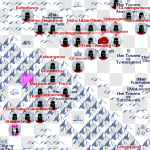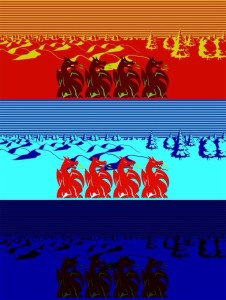A new bug came to light in Doomdark’s Revenge. I had a report of a crash bug that occurs after 138 days, that’s one hundred, one score, and eighteen days since the Moonprince rode forth into the Icemark.
The problem appeared to be that an AI character’s liege was getting set to himself. This causes a problem in the AI logic for a character choosing to follow their liege. The AI goes something like this…
I want to follow my liege, but my liege is dead, so I need to follow my liege’s liege and this character will become my new liege. The code ripples up the liege tree until it finds someone to follow, or bails and decides to hunt down Luxor instead. When the bug occurs it follows the tree and finds a liege who is dead but they are also their own liege, and thus we get stuck in an infinite loop.
Once I found this as the source of the crash, I needed to work out WHY it occurs.
There are only two places where the liege can change, the aforementioned follow liege routine, and being recruited.
I stuck some debug info on both cases and set the game to run on automatic to see if the issue triggered, and it did.
Here is the scenario…
Anvarorn starts with Fangrorn being his liege. Fangrorn’s liege is Shareth. Fangrorn gets recruited by Anvortheon the Barbarian, and thus his loyalty changes to the barbarians, and his new liege becomes Anvortheon. Anvarorn decides to follow his Liege, who is still Fangrorn. When he gets to the same location as him he notices that they are not the same loyalty and thus tries to recruit him. He succeeds. Thus Fangrorn’s liege becomes Anvarorn. So we now have a circular liege issue. This becomes a problem if Fangrorn dies, because in this instance Anvarorn decides to follow his liege, finds that his liege is dead so takes his liege’s liege as his new liege and therefore becomes his own liege!
I went back and checked the original code, and this issue can happen. The only place you would notice it would be on one of the description screens where it would say, Anvarorn’s liege is Anvarorn – or words to that affect. At worst the character would end up following themselves and end up not moving. This is something that has been mentioned as possibly happening in the current version.
When I implemented the liege tree walk, I did just that, I implemented it as a walk up the tree, and because of the circular issue, a dead lord who is their own liege will create a circular loop if they are someone else’s liege. The original code doesn’t do that, it only takes the next liege up the stack and therefore slowly makes its way up the liege tree over a number of nights. Thus no infinite loop.
This would possibly occur with characters following their foe. If their foe is dead it walks the liege tree of the foe to find the next foe.
Fix to follow soon…


